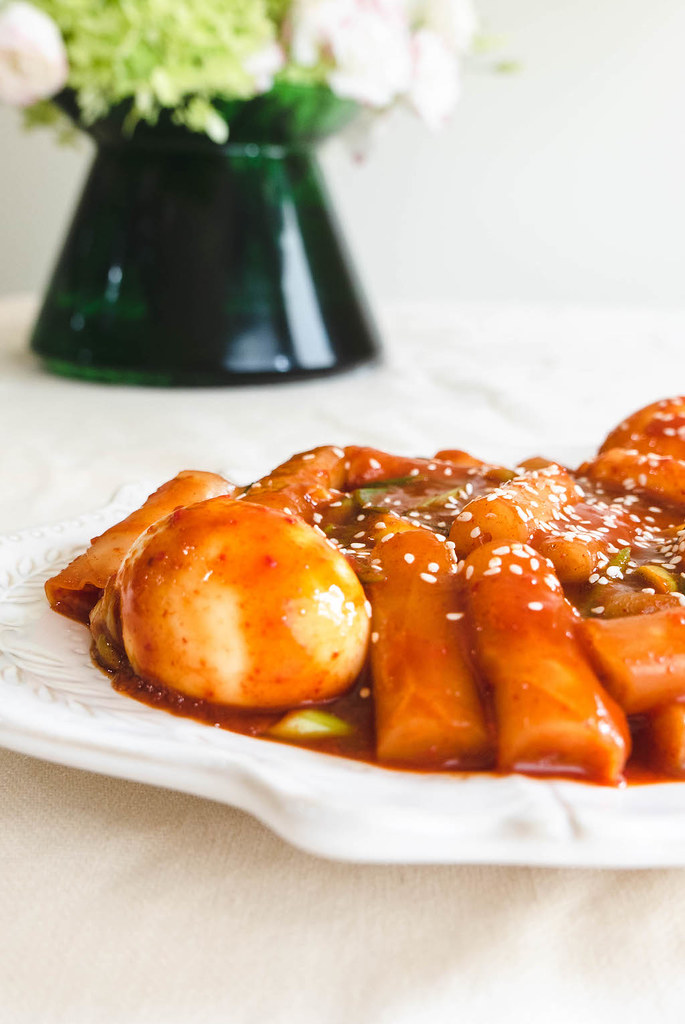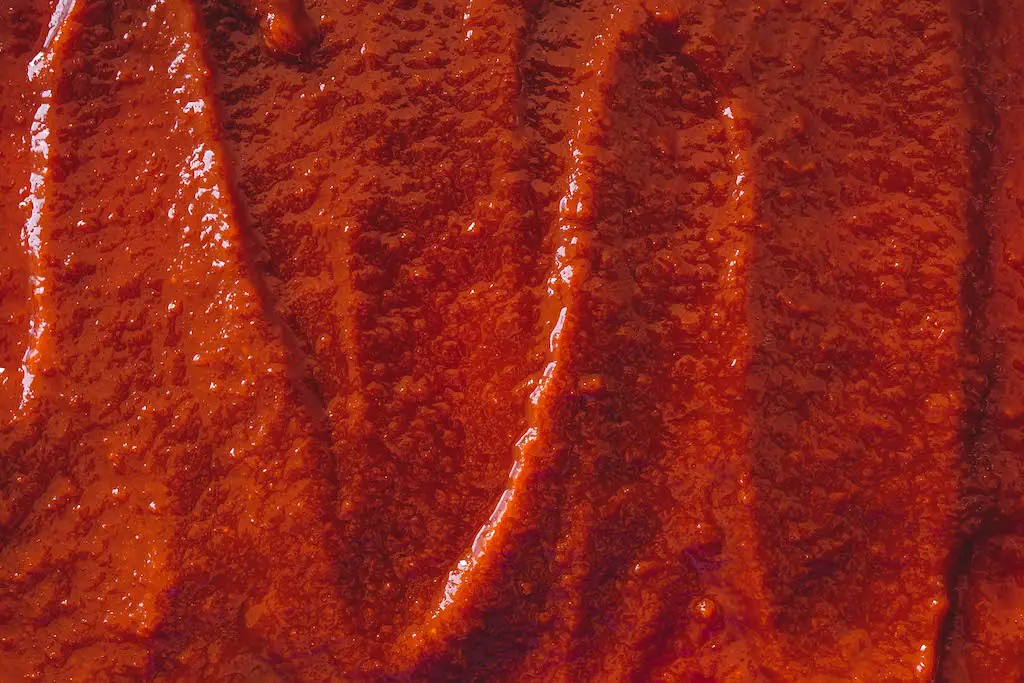This post may contain affiliate links. Please read my disclosure for details at the bottom of this page. As an Amazon Associate, I earn from qualifying purchases on this article about Korean red pepper paste. We hope you enjoy learning the answer to the question: ‘What is Gochujang?’
Gochujang, also known as Korean red pepper paste or red chili paste, is a condiment commonly used in Korean cooking. The word ‘gochujang’ (고추장) derives from ‘gochu’ (고추) meaning ‘chili pepper’ and ‘jang’ (장) meaning ‘paste’ or ‘thick sauce.’ This Korean ingredient has a complex spicy, slightly sweet, and smokey flavor profile unique to Korean cooking.
Here, we will discuss this ingredient that is incredibly important to Korean food culture. First, we will discuss how people make red pepper paste. Then, we will delve into the flavor profile as well as answer some questions you may have about this ingredient!
What Is Gochujang?
To make gochujang, people in Korea ferment a mixture made up of gochugaru (red pepper powder), glutinous rice, meju (fermented soybean powder), yeotgireum (barley malt powder), and/or salt. Once fermented, the mixture turns into a deep-red paste used in stews, soups, stir fry dishes, sauces, and more.
Traditionally, people fermented gochujang in a type of onggi jar known as jangdok. Other types of condiments fermented in these jars include doenjang (fermented soybean paste), chunjang (black bean paste) and ganjang (Korean soy sauce).
What Does Gochujang Taste Like?
Typically, people describe gochujang as having a savory, slightly sweet, and spicy flavor. That being said, the flavor of gochujang can differ based on the brand or ingredients used in a homemade recipe–some recipes taste much sweeter, while others have more spice.
While the typical ingredients include a combination of gochugaru, glutinous rice, meju, barley malt powder, and/or salt, other ingredients can be added which alter the flavor. Some recipes include jujubes, pumpkin, sweet potato, wheat kernels, short-grain rice, sugar, syrup, or even honey. Often, ingredients such as these affect the savory and sweet flavor notes.
Further, the spice level of gochujang is entirely dependent on the red peppers used in the fermented paste. In Korea, you can buy gochugaru (red pepper powder) with different spice levels. While some are extremely spicy, other pepper powders have a milder and sweeter taste. When buying gochujang, always check the labeling–In South Korea, brands often label the containers to let you know the spice level of that particular red pepper paste. Look for labels such as mild (순한맛), medium (보통 매운맛), spicy (매운맛).
Examples of Gochujang Uses in Korean Cuisine:
In South Korea, people use gochujang in many recipes. Besides ganjang (Korean soy sauce), gochujang is probably the most used fermented condiment. Below, I list a few examples of Korean dishes that use gochujang:

How to Use Korean Red Pepper Paste:
- Tteokbokki (떡볶이): Tteokbokki is a dish made by simmering glutinous rice cakes in a gochujang-based spicy red sauce. Often, further ingredients include green onions, fish cakes, eggs, and more. Try making our rice paper tteokbokki hack available on our blog if you cannot find Korean rice cakes near you!
- Tteokkochi (떡꼬치): To make this dish, you place rice cakes in a pan or over a grill to heat until crispy on the outside. Then, you coat the crispy rice cakes in a gochujang-based sauce.
- Bibimmyeon (비빔면): Bibimmyeon is a type of spicy cold Korean noodle popular during the extremely hot summer days. People make bibimmyeon by cooking ramen noodles. Then, you top the noodles with cucumbers, eggs, toasted sesame seeds, and a gochujang-based spicy sauce. You can add more toppings such as steamed pork belly as well!
- Kimchi Jjigae (김치찌개): First to make spicy kimchi stew, you need to prepare the liquid base. You can uses a multitude of ingredients such as kimchi juice, gochugaru, gochujang, and stock. In the end, this thick stew is the perfect dish to consume during the coldest months of the year.
- Bibimbap (비빔밥): Translated to ‘mixed rice,’ this Korean dish features a base of rice topped with different ingredients such as sautéed carrots, spinach, mushrooms, and a protein. Then, people add a gochujang-based sauce before mixing all the ingredients together.
- Ssamjang (쌈장): Ssamjang is a type of thick dipping sauce often served with Korean barbecue. The most basic recipe includes two ingredients: doenjang and gochujang. More complex recipes often include hot peppers, garlic, sesame oil, and more. Learn about some popular Korean dipping sauces here!
These are just a few ways to use gochujang–This list doesn’t even scratch the surface of uses in Korean cuisine.

Korean Red Pepper Paste Frequently Asked Questions:
Now that we learned about gochujang, we can answer some questions you may have about this Korean condiment! If we did not answer your question, feel free to leave a comment below or email us at [email protected].
Where Can I Buy Gochujang?
Nowadays, you can typically find gochujang at a well-stocked grocery store on the Asian aisle. If your grocery store does not carry gochujang, you can easily find it online. Online stores such as Amazon, Walmart, and more carry Korean gochujang.
Or, check if your town has a local Asian market. Often, these are family-run, so you are helping a small business. Many cities also have large Asian market chains such as H-Mart.
Is Gochujang Gluten-Free?
Many people ask: ‘Is gochujang gluten-free?’. Unfortunately, most Korean gochujang brands contain gluten as a main ingredient. That being said, more and more gluten-free gochujang brands are popping up on the market! As someone with celiac disease, this is incredibly exciting for me. While living in South Korea, I had a hard time eating food because of the hidden gluten in the fermented ingredients. I’m so thankful it is becoming easier to cook Korean food gluten-free.
On the blog, I have a list of my favorite gluten-free gochujang brands. On this list, we also provide some soy-free gochujang options as well! Check the list out if you are gluten-free like me!
Further, if you are interested in cooking with doenjang (Korean soybean paste), you can use our guide to gluten-free doenjang brands.
How to Store Gochujang (Red Pepper Paste Storage)?
After buying red pepper paste, unless it states otherwise, you can store unopened containers in a cool and dark place such as the pantry. Once opened, place the gochujang container in the refrigerator.
How Long Does Gochujang Last?
Gochujang stays fresh for an incredibly long time. When stored properly in an airtight container in the refrigerator, an opened container of red pepper paste can last for an upward of two years! Always check the container to make sure there is no molding before use.
I Hope You Enjoyed Learning About Korean Pepper Paste!
In the end, we hope you enjoyed learning about Korean red pepper paste!
If you would like to read more about cooking, you can find further recipes on this blog. I listed some of my favorite Carving A Journey recipes below! For reference, many recipes are influenced by my family’s blended Korean and Southern heritage.
Further Carving A Journey Recipes:
Korean Ingredient Articles:
- Persimmons in Korean Cuisine
- Chunjang Paste (Black Bean Paste)
- Perilla Leaves in Korean Cuisine
- Gochugaru (Korean Pepper Powder)
If you have any questions or comments, you can also email me at [email protected]. And, finally, I would love to hear from you through our social media as well! You can follow me at @carvingajourney on Instagram, Facebook, and Pinterest. I also started a vlog YouTube channel with my husband! Or, if you would like more articles like these, you can subscribe to the blog by joining the mailing list. I hope you enjoyed learning about gochujang (Korean red pepper paste)! Thank you so much for stopping by!
Carving A Journey is a participant in the Amazon Services LLC Associates Program, an affiliate advertising program designed to provide a means for sites to earn advertising fees by advertising and linking to Amazon.com. Although we may earn commissions for our endorsement, recommendation, testimonial, and/or link to any products or services from this website, these opinions are my own and I fully support these products.

